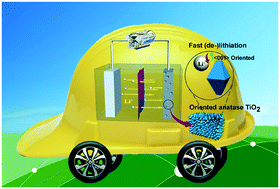Hollow nanocubes constructed from <001> oriented anatase TiO2 nanoarrays: topotactic conversion and fast lithium-ion storage†
Abstract
Mechanically stable titanium dioxide (TiO2) with the abilities of rapidly storing and releasing Li+ can be potentially applied in electric and hybrid electric vehicles, due to its ability to enhance the stability and safety, as well as the high current performance, of lithium ion batteries (LIBs). Herein, we rationally and facilely synthesized <001> oriented anatase TiO2 nanoarrays (OATNs) from the NH4TiOF3 mesocrystal precursor through topotactic conversion and in situ epitaxial growth under moderate conditions. This study proves that the crystallization, porous structure, and orientation of OATNs are controllable, which affect the electronic and electrochemical properties and the Li+ diffusion coefficient. The optimal OATNs formed by hydrothermally treating NH4TiOF3 mesocrystals with an H3BO3 aqueous solution for 10 h (OATNs-10) delivered a high capacity of ca. 115 mA h g−1 at a current density of 50 C (170 mA g−1 of 1 C) even after continuous 2000 cycles with a Coulombic efficiency of ca. 100%. This indicates a high current rate performance and excellent stability. The unique properties of OATNs-10 make them a promising candidate for practical applications in LIBs.



 Please wait while we load your content...
Please wait while we load your content...